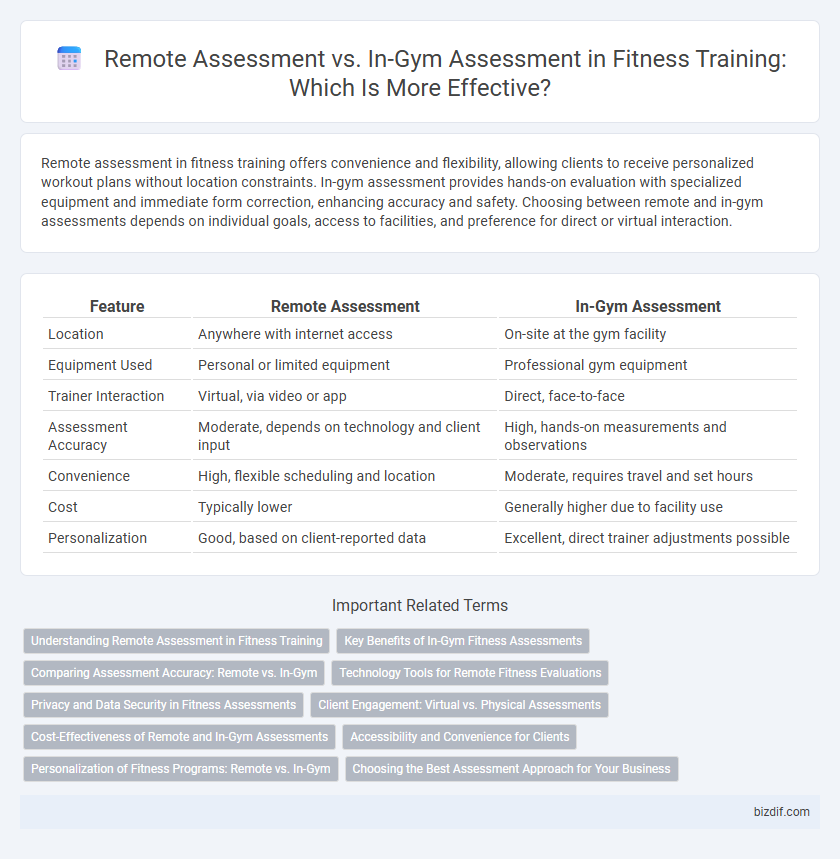Remote assessment in fitness training offers convenience and flexibility, allowing clients to receive personalized workout plans without location constraints. In-gym assessment provides hands-on evaluation with specialized equipment and immediate form correction, enhancing accuracy and safety. Choosing between remote and in-gym assessments depends on individual goals, access to facilities, and preference for direct or virtual interaction.
Table of Comparison
| Feature | Remote Assessment | In-Gym Assessment |
|---|---|---|
| Location | Anywhere with internet access | On-site at the gym facility |
| Equipment Used | Personal or limited equipment | Professional gym equipment |
| Trainer Interaction | Virtual, via video or app | Direct, face-to-face |
| Assessment Accuracy | Moderate, depends on technology and client input | High, hands-on measurements and observations |
| Convenience | High, flexible scheduling and location | Moderate, requires travel and set hours |
| Cost | Typically lower | Generally higher due to facility use |
| Personalization | Good, based on client-reported data | Excellent, direct trainer adjustments possible |
Understanding Remote Assessment in Fitness Training
Remote assessment in fitness training leverages digital tools and wearable technology to evaluate clients' physical performance and progress from any location, providing real-time data on heart rate, mobility, and endurance. This method offers convenience and flexibility, enabling trainers to customize workout plans based on continuous monitoring without in-person visits. Remote assessments enhance accessibility for clients with busy schedules or geographical constraints, while still delivering accurate, data-driven insights for effective fitness progression.
Key Benefits of In-Gym Fitness Assessments
In-gym fitness assessments offer precise body composition analysis using advanced equipment like DEXA scans and hydrostatic weighing, ensuring accurate baseline data. Personalized trainer guidance during in-person evaluations enhances technique correction and motivation, leading to more effective workout plans. Access to a controlled environment with specialized machines enables comprehensive testing of strength, endurance, and flexibility for targeted fitness goal tracking.
Comparing Assessment Accuracy: Remote vs. In-Gym
In-gym assessments typically provide higher accuracy due to direct access to professional equipment and real-time, hands-on evaluation from trainers, enabling precise measurement of physical performance and form. Remote assessments rely heavily on video quality, user self-reporting, and limited equipment, which can result in variability and potential inaccuracies in data collection. Advances in technology, such as wearable sensors and AI-driven analysis, are improving remote assessment precision but still often lag behind the controlled environment of in-gym evaluations.
Technology Tools for Remote Fitness Evaluations
Remote fitness assessments leverage advanced technology tools such as wearable devices, mobile apps, and video conferencing software to collect real-time biometric data and monitor exercise form. These tools enable trainers to conduct personalized evaluations without physical presence, enhancing accessibility and convenience for clients. Compared to in-gym assessments, remote evaluations rely heavily on technology integration to ensure accurate tracking of performance metrics and progress.
Privacy and Data Security in Fitness Assessments
Remote fitness assessments leverage encrypted platforms and secure data storage to protect client privacy, minimizing the risk of unauthorized access compared to traditional in-gym assessments. In-gym evaluations often require physical documentation and manual data handling, increasing exposure to potential data breaches and less controlled environments. Prioritizing robust cybersecurity protocols and compliance with data protection regulations ensures confidentiality and trust in both remote and in-person fitness assessments.
Client Engagement: Virtual vs. Physical Assessments
Remote fitness assessments leverage video technology to maintain high client engagement by enabling real-time feedback and personalized adjustments despite physical distance. In-gym assessments foster direct interaction, allowing trainers to observe subtle body mechanics and motivate clients through immediate physical presence. Both methods emphasize client commitment, but virtual sessions rely heavily on digital tools to simulate in-person engagement effectively.
Cost-Effectiveness of Remote and In-Gym Assessments
Remote fitness assessments typically offer greater cost-effectiveness by eliminating travel expenses and facility fees, making them accessible for clients with budget constraints. In-gym assessments, while potentially more expensive due to equipment and overhead costs, provide hands-on guidance and immediate feedback that can enhance training quality. Evaluating cost-effectiveness depends on balancing the financial savings of remote options with the value-added benefits of in-person assessments.
Accessibility and Convenience for Clients
Remote assessment offers unparalleled accessibility by enabling clients to engage in fitness evaluations from any location, eliminating travel constraints. This convenience allows for flexible scheduling and immediate feedback, which can enhance adherence and consistency in fitness programs. In contrast, in-gym assessments provide hands-on guidance and direct equipment use but may pose accessibility challenges for clients with limited mobility or time restrictions.
Personalization of Fitness Programs: Remote vs. In-Gym
Remote assessment leverages digital tools and wearable technology to gather real-time data, enabling personalized fitness programs tailored to individual progress and preferences without geographical constraints. In-gym assessment offers hands-on evaluation through direct observation and immediate adjustments by trainers, enhancing accuracy in designing customized workout plans. Both methods provide personalized fitness regimens, but remote assessments deliver flexibility, while in-gym assessments emphasize precision and direct interaction.
Choosing the Best Assessment Approach for Your Business
Selecting the ideal assessment method hinges on your business model, client accessibility, and technology infrastructure. Remote assessments leverage virtual tools and wearable technology to provide flexible, data-driven insights, ideal for businesses targeting a broader, tech-savvy audience. In-gym assessments offer hands-on evaluations with specialized equipment and direct supervision, enhancing accuracy and personalized programming for clients seeking intensive, in-person guidance.
Remote Assessment vs In-Gym Assessment Infographic

 bizdif.com
bizdif.com